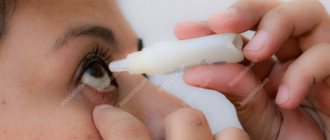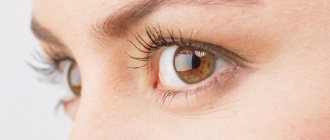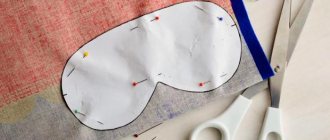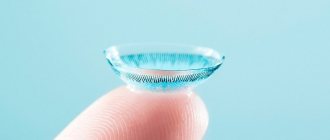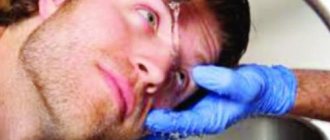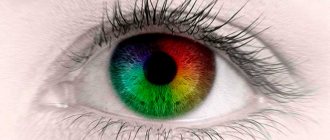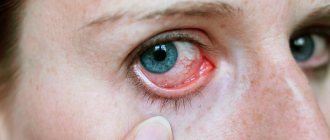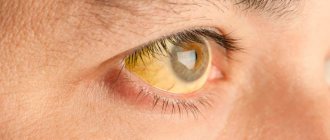What to do if a speck or other foreign body gets into your eye? In this material we will look at how to provide first aid in such a situation if it is not possible to call a doctor.
Most often, a foreign body that gets into the eye does not pose any particular danger to the organ of vision. However, you should worry if scale (spark from welding) or a piece of metal gets into your eye, as it can damage the retina. Why is it so dangerous for metal particles to get into the eye? The fact is that if the metal particle is not removed from the eye in a timely manner, it will begin to oxidize. This can lead to deterioration of vision, up to its complete loss. That is why it is very important not to delay providing first aid and quickly get it out of the eye. Of course, it is best to contact an ophthalmologist directly, who will use special tools to remove the foreign body, but if it is not possible to call a specialist, you will have to act on your own.
How to get a speck out of your eye?
Prompt assistance will help to avoid the serious consequences of debris entering the visual organ. Even a small speck can scratch the inside of the eyelid, and a small sliver can even get stuck in the sensitive, moist membrane of the sclera.
To get rid of a foreign object under the eyelid, you should proceed in stages:
- Wash your hands. Carry with you an antibacterial spray or gel that will instantly disinfect the surface of your fingers, which can easily remove the speck. If the incident happened on the street, run to the store for wet wipes.
- If the cause of the irritation is not visible in the mirror, run your finger along the edge of the lower and upper eyelids. Often lint from a cotton pad or clothing remains there. Then lightly press the row of eyelashes and pull, there may be fiber left there after removing the makeup.
- If a speck is found, try to point it closer to the bridge of the nose, where it is easier to reach. To do this, close your eyes and smoothly move along your eyelids - from the temple to the center of the face. Movements that describe the image of a circle will also help: clockwise when discomfort is felt under the lower eyelids, and counterclockwise when under the upper eyelids.
- To stimulate the process of natural defense, that is, the removal of midges, litter or lint with the help of abundant tear production, it is enough to blink often. If there is no reflex or during this period you are sick and for some reason physiological fluid is not released, use clean water. It should not be cold - when taking a couple of drops into the pipette, hold the glass part in your fist until it warms up.
- It is better to make direct contact with the interfering particle with a damp cotton swab, the edge of a clean napkin or your finger. Forget about tweezers, toothpicks, and even more so needles.
- At home, you should rinse your eyes. Try to use purified, filtered or boiled water, as running water is saturated with chlorine. The aggressive substance causes irritation of the already damaged shell. Fill a basin with warm water and dip your face in it. When your body gets used to it, open your eyes. The speck must come out on its own.
- If you get lime during construction or renovation, use a solution of sugar and water in proportions of 1 tablespoon per 1 liter. Rinse your eyes with it 2-3 times, and then wash with plain water. The burning sensation should go away instantly.
What to do
Firstly, don’t panic and start rubbing your eye with all your might, otherwise it will become more difficult to remove the midge from your eye. Doctors advise doing the following: close the affected eye for 15-20 seconds and wait. After this, tears should flow from him. Blink well, and soon the tear fluid will drive the midge into the corner of the eye, where it will be easier to remove.
To remove the insect, it is better to use a scarf or napkin, the corner of which must be moistened with water. Do not use a dry cotton swab for this: cotton fibers will get into the mucous membrane and can cause irritation. It’s good if you have a mirror at hand at this moment. Using the tip of a damp cloth, carefully hook the midge and remove it.
You can do it another way: with both hands, carefully spread your eyelids and make a movement as if you are going to blink. If there is a source of water nearby, then collect it in a container, lower your open eye into it and imitate blinking. In this case, the small insect should “float” out of the eye.
Removing sharp objects (metal shavings and others)
Sawing wood products, clearing dry brushwood in the garden with power tools, and processing wood into sawdust with motorized equipment are tasks that must be undertaken in compliance with technical and safety regulations. By not using special safety glasses, you increase the risk of tiny splinters getting into your eyes, which, with their sharp ends, cause damage to the delicate surface of the organ. The same rule applies to metal processing, working on a lathe, and being involved in the recycling of iron shavings.
The danger lies not only in the scratches that such objects leave, but also in the fact that a thin narrow sliver easily enters the sclera or the inside of the eyelid. This is fraught with:
- penetration of infection;
- destruction of the capillary network;
- subsequent injury during blinking.
You can try removing metal objects using a magnet. The larger it is, the further away from the eye it can be placed. Of course, before use it should be washed thoroughly with liquid soap. If the attempt is unsuccessful, do not hesitate, consult a therapist.
Return to contents
Why does eye pain occur when blinking?
During infectious and inflammatory processes, pain may appear first in one eye, but after one or two days it will spread to the other. Often this symptom is accompanied by stye, inflammation of the conjunctiva, which is caused by bacteria or viruses, and sinusitis. If a patient complains of pain, doctors, as a rule, always prescribe a comprehensive examination, since this sign is included in the symptoms of a wide variety of pathologies and conditions, and not only of an ophthalmological nature.
If one eye hurts, then the reason lies in an infectious disease or:
- corneal ulceration;
- astigmatism;
- inflammation of the blood vessels of the eyes;
- hemorrhage in the eye;
- scleritis (inflammation in the fibrous membrane of the eyeball);
- inflammation of the iris.
What to do after removing the speck?
While relaxing in nature or in the center of a busy metropolis, where there is no opportunity to rinse your hands and face, at least try to blink frequently. A good result of such manipulation will be a stream of tears flowing down the cheek. It’s worse if the fluid is released in insufficient quantities, then microscratches can cause discomfort for a long time.
If you find yourself at home, in such a situation you should rinse your eyes thoroughly. If possible, use herbal infusions. After preparation, strain thoroughly so as not to leave a single leaf, and apply the liquid to a cotton swab or drop it with a pipette. For complete recovery, close your eyes for a few minutes and rest.
Return to contents
When should you see a doctor?
If the speck in the eye is not removed, it is probably embedded in the soft tissue. You must urgently visit the nearest hospital, from where you will be referred to a specialist. Without knowing the extraction technology, you shouldn’t try to eliminate the cause of discomfort yourself.
Other indications for an urgent visit to the doctor are prolonged painful or simply unpleasant sensations. When the speck is removed correctly, the eye returns to normal in a short period - from 10 minutes to 2 hours. If this does not happen, the problem may be larger than you thought, and professional help is indispensable.
Eyewinker
Various kinds of specks, grains of sand, crumbs, eyelashes, midges, etc. often get into the eyes of both children and adults, especially in the summer. In most cases, you can cope with the problem yourself by removing the foreign body from the eye by rinsing or even using your fingers, but sometimes you have to seek the help of a specialist. How to remove speck in the eye yourself?
This can be done by rinsing the eye with boiled water. To do this, you need to lower your face into the water or scoop it up with your palms, and then blink frequently so that the water can wash away the speck. If a splinter gets under the lower eyelid, pull it down and try to rinse the eye.
Or try to pick up a foreign body from the eyelid with a wet cotton pad (under no circumstances use dry cotton so as not to injure the eye by friction and leave lint in it). If a splinter has gotten under your upper eyelid, also pull it back and tug back and forth several times.
After removing the speck from the eye, it is necessary to rinse the eye with clean water and drip a disinfectant, for example, Albucid, Tobrex or levomecithin drops.
Eye drops
After a speck in the eye has left a mark in the form of a scratch, there is a risk of infection. To avoid problems, you should take a course of antibacterial agent. Ophthalmologists recommend the use of antibiotics or antiviral agents, which are applied in liquid form directly to the damaged membrane. For calmness and quick healing, it is also recommended:
- gel “Korneregel” - envelops the delicate mucous membrane of the eye and relieves irritation;
- “Thiotriazolin” - has a membrane-stabilizing effect and is an antioxidant;
- “Sulfacyl” has a broad spectrum antibacterial effect.
If you don’t have the above medications in your home medicine cabinet, try using any drops that imitate tears. With the advent of computers and gadgets, such assistants appeared in every family where there is a programmer, accountant or gamer. They help combat the dryness that haunts assessors behind the monitor. Artificial tears are also useful in this situation - they will wash away the remaining debris and soothe the eye.
Return to contents
Traditional anti-inflammatory drugs
To remove redness from the eyes after the speck has been removed, use herbal infusions. The percentage of dry matter in the water should be low - a tablespoon per liter. This will be enough to bring benefit and not harm.
It is advisable not to brew the herb, but to boil it for 1-2 minutes. After cooling, you must carefully strain the resulting broth. If this did not work the first time and sediment is visible at the bottom of the vessel, repeat the procedure.
Great for relieving inflammation:
- oak bark - instantly narrows blood vessels and strengthens them, removing redness in a matter of hours;
- chamomile - soothes and relieves discomfort from the skin of the eyelid and mucous membrane of the eye;
- tea - it is even used in bags, applying them to open eyelids. The main requirement is that it does not contain chemical dyes or flavors.
How to avoid foreign objects getting into your eyes?
There are simple safety rules, following which you will save yourself from unpleasant sensations and reduce the risk of an attack on the health of your vision. You cannot foresee all situations in life, but for some there are preventive instructions:
- When working with power tools that work metal or wood, do not forget to use special glasses. They will protect the eye sockets both from the front and from all sides, thanks to the wide arms.
- Don't forget to wear sunglasses on the beach. Wearing an accessory is both good for vision and protects the mucous membrane from grains of sand.
- Teach your children hygiene - do not rub their eyes with dirty hands, do not throw sand at each other, do not climb under furniture in places where dust has accumulated.
- If you have to do the repairs yourself, do not forget to wear protective glasses when removing old plaster and even wallpaper. This small debris settles especially quickly on the wet surface of the eye and is difficult to remove.
Why does the eye hurt when pressing and blinking?
Common causes of pain when light pressure is applied to a closed eye and blinking are fatigue, overwork, or improper wearing of contact lenses. Usually the discomfort goes away quickly. It is enough to give your eyes a little rest from the monitor, book or lenses. Also, pain is caused by incorrectly selected lenses or glasses when a person purchases optics without an ophthalmologist's prescription. But other pathologies cannot be ruled out. With chronic glaucoma, the pain is almost constant and gets worse. The disease also manifests itself in diplopia (double image) and impaired color vision (including blurred vision in the dark).
It is painful to blink and touch the eye due to tumors (benign and malignant) that are located on the back of the eyeball. In this case, the pain almost never goes away and intensifies when a person touches the eyelids and eyes.
